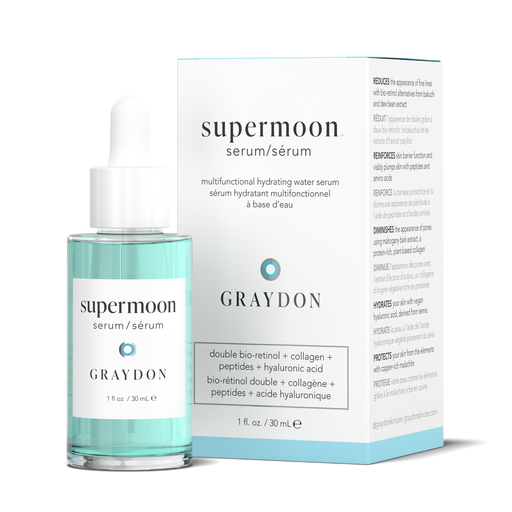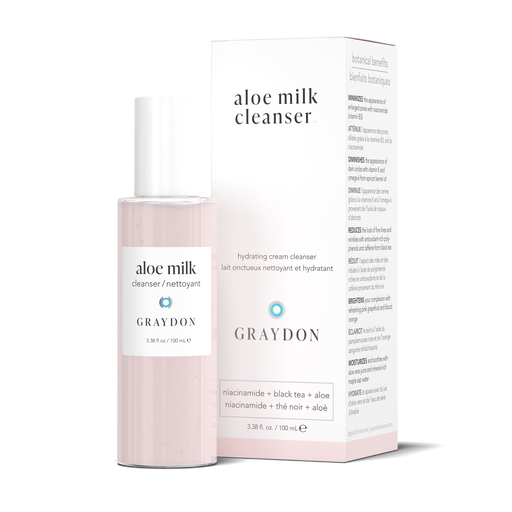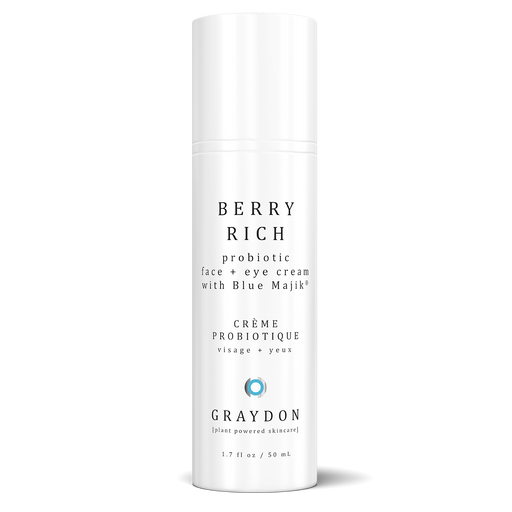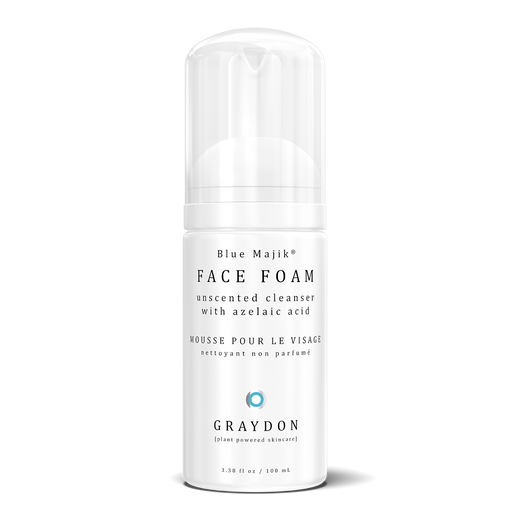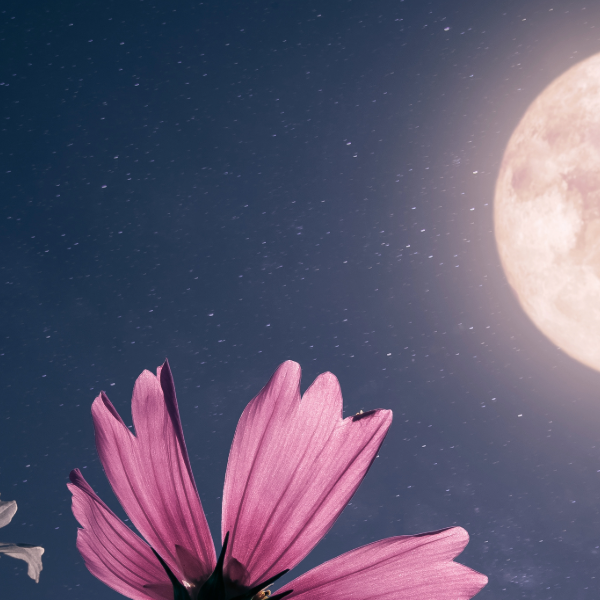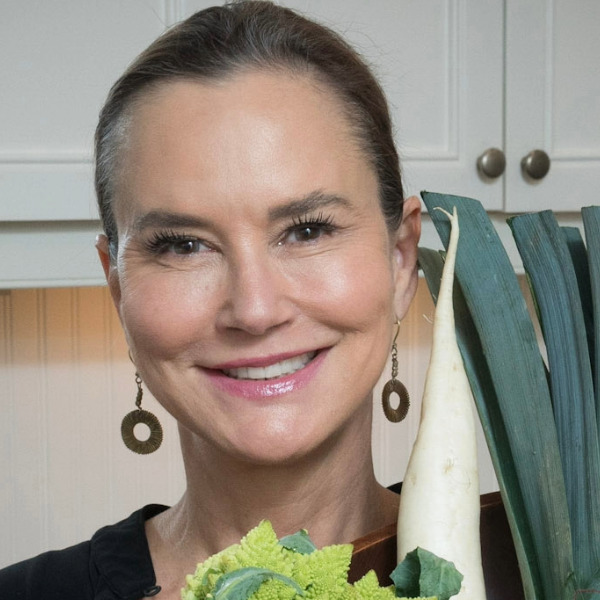IN THIS ARTICLE:
- How is vitamin A related to retinoids?
- A little history about retinoids
- The different types of retinoids
- The benefits of retinoids
- Retinoids and vitamin A in Graydon Skincare products
- Final words
For over 50 years, vitamin A has been the most common skincare ingredient used to slow the signs of aging. In fact, it was actually the first vitamin to be approved as an anti-wrinkle agent by the Food and Drug Administration (FDA).
Basically what I’m saying is, if you want to help your skin age as gracefully as possible, vitamin A is an ingredient that you should add to your skincare routine.
So in today’s article, let’s journey down the vitamin A rabbit hole. Be warned, it’s a big vortex of confusion that a lot of people are perplexed by. That being said, when you know the science behind this superstar skincare ingredient, you’ll totally understand what you’re using and why you’re using it.
Now, without further ado, let’s get started!
How is vitamin A related to retinoids?
The term retinoids refers to a group of fat-soluble chemicals that are derived from vitamin A. Retinoids include beta-carotene, retinyl esters, retinol, retinaldehyde and tretinoin. There are a few others, but let's not complicate things too much.
When it comes to topical skincare products, you can either get an Over-The-Counter (OTC) or prescription retinoid. OTC retinoids include ingredients like retinol, retinyl esters and retinal.
On the other hand, there are retinoids called tretinoin/retinoic acid (or all-trans-retinoic-acid) and tazarotene that are not sold in just any skincare shop. You can only get your hands on these retinoids if you have a prescription from a physician, like a dermatologist. Of these prescription retinoids, tretinoin is more widely used than tazarotene and is regarded as the strongest, most efficacious type of retinoid.
A little history about retinoids
Now that we have a rough understanding of what retinoids are, let’s take a look at their history, how they were invented and how they were used.
In 1930, Professor Paul Karrer, a Swiss organic chemist, established the correct constitutional formula for b-carotene, the chief precursor of vitamin A. This was the first time that the structure of a vitamin or provitamin had been established. In 1931, Karrer extracted vitamin A from cod-liver oil and identified its chemical composition. He then went on to win a Nobel Prize in 1937 for determining the structure of retinol.
Twelve years later, in 1943, retinol was successfully synthesized. Since then, these types of vitamin A derivatives started to pop up and become commercially available.
In the late 1960s, two American dermatologists named James Fulton and Albert Kligman co-developed tretinoin at the University of Pennsylvania. Originally, this ingredient was intended to treat patients with severe cases of acne. However, during the primary clinical trials, the researchers noticed that patients also seemed to have smoother and less wrinkled skin, on top of a reduction in acne. This led to research into tretinoin’s pro-aging benefits.
The different types of retinoids
As you now know, retinoids is an umbrella term that refers to a group of vitamin A-derived ingredients. Now let’s take a closer look at the different types of retinoids and how they relate to each other. From least potent to most potent, least irritating to most irritating, they are:
- Retinyl esters, which can be regarded as the weakest, most gentle retinoids, including retinyl acetate, retinyl palmitate and retinyl propionate. They are three conversion steps away from tretinoin.
- Retinol, which is used by the majority of skincare brands. It is two conversion steps away from tretinoin.
- Retinaldehyde (or retinal for short) is a step above retinol in terms of strength and efficacy. It is only one conversion step away from tretinoin.
- Tretinoin / retinoic acid is the strongest retinoid and is most bioavailable to our skin, meaning that our skin can just accept and metabolize it as it is.
Now, you might be wondering, what’s up with all these conversion steps? What do they mean?
Well, to understand that, we must first take a quick skin anatomy lesson.
Skin tissue has these tiny, magical things called nuclear receptors. There are two main types: Retinoic Acid Receptors (RARs) and Retinoid X Receptors (RXRs). For each of these nuclear receptor types, there are three subtypes: alpha, beta and gamma. These receptors are basically the doormen of our skin, helping to welcome retinoids in so they can work their magic.
Tretinoin is the only retinoid that is able to bind to all six of these receptors without any assistance. The other types of retinoids, such as retinol or retinal, need to be converted by the enzymes in our skin to transform into tretinoin.
Oh, before we move on! You may have heard the term Retin-A and wondered if it’s related to retinoids. It is. However, Retin-A isn’t an ingredient, it’s a well-known brand name for a prescribed topical medication that uses tretinoin as the main active ingredient.
The benefits of retinoids
Now, this is the fun part, but also the most overwhelming part. I mean, since retinoids are a whole group of different ingredients, which specific type of retinoid should we dissect?
Just for the sake of this article, I will focus on topical retinol. The reason being that it is the most common form of retinoids that most brands tend to work with.
However, the good news is that all retinoids should have more or less the same effects on the human skin, albeit to various degrees depending on multiple factors. So basically, even if I’m describing retinol, you can more or less make the same connections to the other members of the retinoids family as well.
Here are the top three benefits of this ingredient:
Fight acne
As I mentioned, this is the reason tretinoin was created in the first place. And naturally, retinol also shares this same powerful characteristic. In case you aren’t aware, there are two types of acne: non-inflammatory (blackheads, whiteheads) and inflammatory (papules, pustules, nodules, cysts). Retinol can help fight both.
According to this 2017 paper, retinol is able to alleviate acne and breakouts by speeding up the natural process of skin cell turnover. In simpler words, it can help our skin to exfoliate itself quicker and more effectively. By doing this, it can remove the “dead skin cells” that block our pores, which is the main cause of non-inflammatory acne.
It is also able to block several important inflammatory pathways that are activated in acne. By blocking these pathways, it also reduces the release of inflammatory molecules and inhibits cellular inflammation. This, in turn, alleviates the symptoms of inflammatory acne.
Reduce fine lines and wrinkles
Just to be clear, I think fine lines and wrinkles are wonderful. I like to think of them as beauty marks, as they show that we have lived our lives to the fullest, through all of its ups and downs. However, I also understand that premature skin aging isn’t something that many people desire.
This is where retinol becomes the gift that keeps on giving.
According to this 2019 research review, retinol can help minimize fine lines and wrinkles in many different ways. For one, it can prevent the collagen and elastin in your skin from breaking down, while simultaneously improving the collagen and elastin synthesis process. Since these are the two important proteins responsible for our skin’s youthful, plump and smooth appearance, this benefit is golden.
On top of that, with consistent, long-term use, retinol can thicken the epidermis. It does this by strengthening the junction between the top layer of the skin and the lower layer of the skin. This helps reinforce the skin barrier and prevents excessive transepidermal water loss. And as we all know, hydrated skin is happy, healthy skin!
Alleviate hyperpigmentation
Retinol can also lighten up dark spots and brighten your overall complexion. And since these two factors are also responsible for a premature-aging skin appearance, this also adds to retinol’s reputation as a pro-aging ingredient.
This has been demonstrated in many studies. In an 8-week study in 2020, researchers recorded an overall reduction in hyperpigmentation and uneven skin tone across 28 participants. A 12-week study in 2018 indicated an overall improvement in patients with photoaging skin (this is in conjunction with bakuchiol, a personal fav!) As a general understanding, retinol does this thanks to its powerful ability to improve skin cell turnover and collagen synthesis.
Retinoids and vitamin A in Graydon Skincare products
Let me just get this out of the way: Our products don’t actually contain retinoids.
I know, I know. Why write an entire article about ingredients that we don’t actually use? And with all the benefits of retinoids, why wouldn’t we want the power of these phenomenal ingredients in our products? You may also be thinking, “Don’t your products contain vitamin A? Isn’t that the same thing?”
These are all great questions, and I’m going to answer them right now.
We choose not to formulate with retinoids because it doesn’t align with our ethos.
The truth is, the majority of retinoids on the market are synthesized in labs, and they tend to be derived from animal-based sources. As a brand that’s dedicated to results-driven, plant-powered ingredients, we focus on formulating our products with ingredients that are naturally sourced.
Instead, our products contain natural sources of vitamin A.
And no, retinoids aren’t 100% the same as vitamin A.
Think of it this way: In order to make coffee, you need to boil water and run it through coffee grounds, right? So when you drink coffee, does it mean that you’re drinking water? Of course not! You can apply similar logic to our case: We use sources of vitamin A in our products, such as raspberry seed oil, carrot seed oil, and rosehip seed oil. This helps us stay true to our brand, while still utilizing the power of this amazing family of ingredients.
You’ll find vitamin A from rosehip seed oil in our Skin Stuff Face + Eye Cream. You’ll find raspberry seed oil and its vitamin A benefits in Face Glow and Moon Boost Serum. We’ve also formulated Moon Boost Serum with carrot seed oil!
On top of these sources of vitamin A, we formulated Phyto Clear and Fullmoon Serum using other plant-based ingredients with retinol-like effects. They are bakuchiol and moth bean extract. These ingredients, despite not being related to the retinoids family at all, still offer comparable benefits.
Final words
So to recap, retinoids are a group of multiple vitamin A-derived ingredients. They are touted as the royal family of the skincare world thanks to their proven track record of reducing acne, improving fine lines and wrinkles and brightening hyperpigmentation.
Generally, retinoids are synthetic ingredients so we formulate our products with natural sources of vitamin A and other plant-based ingredients that offer retinol-like benefits.
I truly hope that I’ve helped to clear up some of the confusion between vitamin A and retinoids.
__________________
Considered one of the most expensive skincare oils, prickly pear seed oil has skincare benefits that make the price tag worth it. Click here to learn more!


